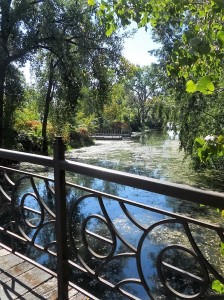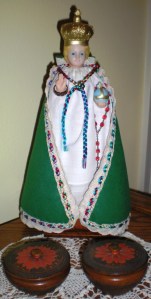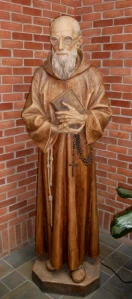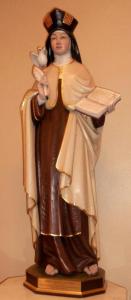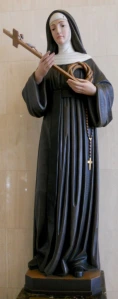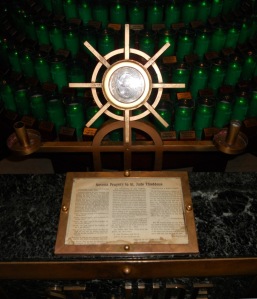I’m grateful for having found St. Mary of Victories (SMV) online because God planted the seed then, two or three years ago, that he harvested today. His playfulness is uplifting. I’ve learned that listening to the voice leads me to discover the Holy Infant waiting for me. His peek-a-boo antics are delightful. Most of all, I love that God places wonderful folks on my faith journey (My email to Cathy and Bill Saccente, parishioners, who welcomed us sweetly before nine o’clock Mass; 10.9.16, edited).
Call of service
Outdoor scenes
Parish hall
About the church
After Mass, Max Kaiser, acolyte and lector who serves at St. Mary of Victories “most of the time,” spoke to us about the church and, afterwards, shared a bit of family history and service to the community (October 9, 2016; transcribed audio recording, edited).
 This church was dedicated to our Blessed Mother. It was the first ethnic parish of the archdiocese established by the Old Cathedral in 1843 by the Germans who immigrated to the United States in large numbers. It was the home for the Maronite community when they came over in 1890s and established St. Raymond’s Maronite Cathedral here. And it was yet a third spiritual home to the Hungarian expatriates who fled the Communist revolution of Hungary in 1955 and 1956. Today it is an indulgence church. You’ll note that the altar was dedicated with the consecration by Pope Leo XIII [1878-1903], granting a plenary indulgence. That means [that,] at the time of death, if an individual is in a state of grace and makes a worthy Holy Communion, they get four hundred days’ remission off their stay in purgatory. And that is a specific request by Leo XIII to this specific church.
This church was dedicated to our Blessed Mother. It was the first ethnic parish of the archdiocese established by the Old Cathedral in 1843 by the Germans who immigrated to the United States in large numbers. It was the home for the Maronite community when they came over in 1890s and established St. Raymond’s Maronite Cathedral here. And it was yet a third spiritual home to the Hungarian expatriates who fled the Communist revolution of Hungary in 1955 and 1956. Today it is an indulgence church. You’ll note that the altar was dedicated with the consecration by Pope Leo XIII [1878-1903], granting a plenary indulgence. That means [that,] at the time of death, if an individual is in a state of grace and makes a worthy Holy Communion, they get four hundred days’ remission off their stay in purgatory. And that is a specific request by Leo XIII to this specific church.
One of the other things I might note is [that the church] was consecrated at the behest of Pope Pius IX… in 1866. That’s why we have the brass candelabra on the wall. Archbishop Peter Richard Kenrick [1843-1895] anointed each pillar with chrism oil— the oil of kings and bishops— to consecrate and dedicate this church formally to Roman Catholic worship and to no other purpose.
Consecrations are specifically governed by canon law. They are not easily bestowed; they are not easily revoked. We’ve had twenty-six consecrated churches in the archdiocese. In the three-hundred-year history of the diocese, only one has been closed; and it took twenty-six years for the Vatican to lift the consecration of St. Liborius Church on Hogan and Market [North 18th Street], which some of you may remember.
You may also be interested to know about these triangular reliquaries and the large red ones and other relics we have embedded in the altars. We are the third largest repository of relics in the archdiocese after both cathedrals and the CSJ motherhouse. That’s the Sisters of St. Joseph of Carondelet down on [Holly Hills] and Minnesota Avenue and, itself, worth a visit to see the remarkable chapel where they have the body of a child saved from Roman times entombed.
You’ll also notice the wonderful organ we have in the back choir loft built in 1856 by [?] Jacob Pfeiffer. And, immediately above it, we have the crest of Pope Benedict XVI, Cardinal Ratzinger, the first German pope in seven-hundred years. As the first German church of the diocese, we’re honoring him [by using], at his request, the emblem of his office using a mitre rather than the tiara which is on Pope St. John Paul II’s coat of arms here.
As an overture ecumenically to our East Orthodox brethren, he switched to the mitre for his coat of arms and incorporated elements of his see in Munich-Freising, Germany that he was promoted by them to become pope. And, having ancestors from Bavaria, that means a little something to me.
The stained-glass windows were made between 1846 and 1896 by two firms: the Hoffman Company and the Emil Frei Art Glass Company. The Hoffman Company went out of business in 1890; the Emil Frei Art Glass Company is still in business. And you might have seen the article in the Post-Dispatch last week on Erin and Nicholas Frei who have been down to this church as visitors along with their dad and granddad, Robert Frei, who was the gentleman who inherited the studio from Emil Frei, Sr., himself a Bavarian immigrant who came first from San Francisco in the 1890s, then to St. Louis and really developed the art of stained glass for Roman Catholic, Lutheran, evangelical, and many other denominational churches.
And the thing that means something here also is [that] these pews, this remarkable communion rail, that baptismal font were all fabricated along with most of the altars by Professor Maximilian Schneiderhahn. And, even though Maximilian is my first name, we are not related.
He was the first liturgical artist brought from Germany by Archbishop Kenrick to make church interiors for Catholic churches that were being built. This was his first church interior; St. Pius V on South Grand Avenue was his last. And he worked in stone, wood, marble, plaster, all sorts of media. He made these pews in 1846. He made that baptismal font in 1834. More than fifteen-thousand people have been baptized. And, our most recent addition, in terms of liturgical history, is the statue made of Father [now] Blessed Francis Seelos, a nineteenth-century Bavarian priest, in the Vatican statuary foundry in Italy. I was privileged to uncrate it twelve years ago.
We also have a copy of Blessed Francis Seelos’s death mask on the side altar. You’re welcome to take a look at it. We have a portion of his sternum bone, which is locked in our safe in one of the reliquaries that honors him. And we’re hoping the second miracle gets validated so he can be canonized— the second saint in the metro St. Louis area after Mother Philippine Rose Duchesne.
The church is remarkably churched. As I said, it’s a granddaddy of all the ethnic parishes of the archdiocese, of all nationalities. It is especially loved by many of the Marian Catholics in the St. Louis area. And the Germans, the Hungarians, and the Lebanese all revere this church. St. Raymond’s, even though it’s Maronite Rite, is very supportive of our continuance.
Something the guys and gals in this day and age might want to know, is [that] the archdiocese allows churches like ours that are historic to be open for Catholic weddings from Catholics outside parish boundaries. Many of you grew up in the suburbs and, if you choose to hold your wedding here, you can. And you can even bring your own priest, if you so choose.
Father Harrison, who is our chaplain— we are a chapel of ease of the archdiocese— will do the final paperwork; but the priest who will marry you will have responsibility for the preparation and the actual ceremony. And we’ve done that many times.
I invite you to walk around and see all the remarkable artworks in the church. And, when you realize that this church is 174 years old, in this type of condition, it’s pretty obvious Our Lord wants St. Mary of Victories Church to continue.
So, welcome, and thank you all for coming today.
Max is a Knight of the Holy Sepulchre, an honor bestowed on him by Cardinal Ratzinger for his part in preserving historic churches.
 My dad, my uncle, and, to a lesser extent, myself were German liturgical craftsmen who fabricated and plated the bronze, gold, and silver textures in the churches for the Catholic, Eastern Orthodox, Episcopal, Lutheran, and some of the Reform churches. Many of the Reform churches use rather notable metal ware, believe it or not. We’ve had our business for more than 118 years.
My dad, my uncle, and, to a lesser extent, myself were German liturgical craftsmen who fabricated and plated the bronze, gold, and silver textures in the churches for the Catholic, Eastern Orthodox, Episcopal, Lutheran, and some of the Reform churches. Many of the Reform churches use rather notable metal ware, believe it or not. We’ve had our business for more than 118 years.
[My dad and my uncle] volunteered down here in the 1930’s, [and] I’m glad to keep the tradition going. I really like the German, the Hungarian, [and] the Lebanese who settled this church because… they [were] more flexible. You could join the parish even if you weren’t that ancestry, [and] now we have all nationalities represented.
Come back anytime and have a great visit.
Blessed Francis Xavier Seelos, CSsR
Prayer from SMV church bulletin
Our heavenly Father, long ago you inspired our… forefathers in the faith to raise this beautiful house of prayer and sacrifice in honor of your Son’s most holy mother, Our Lady of Victories. Your providence then brought many… here under the co-patronage of this holy king, St. Stephen. We humbly place before you today the spiritual and temporal needs of our historic church and its present-day community. Grant us the grace to discern your holy will and to fulfill it zealously as faithful witnesses to the gospel here in the old heart of our city for as long as it may please your divine majesty.
St. Mary of Victories, pray for us. St. Stephen of Hungary, pray for us. In the name of the Father and of the Son and of the Holy Spirit. Amen.
November 9, 2016
“The world tells us to seek success, power, and money; God tells us to seek humility, service, and love” (Pope Francis).
December 15, 2016
The Christian heart has always known Mary as the essence of compassion and love, to whom man can turn with particular and unreserved confidence. This is expressed so well by the intimate name that was given her from the beginning, the name of mother (Fr. Romano Guardini in The Rosary of Our Lady).
March 5, 2017
Mother Mary is right there with us, granting her graces and lovingly pushing us forth— always towards her son, Jesus, so that we will be able to continue each day to put one foot in front of the other to walk in faith (Donna-Marie Cooper O’Boyle in Our Lady of Fatima).
June 1, 2017
“For our leader, the Divine Word, does not demand a strong body and beautiful countenance or high and noble birth, but a pure soul well-grounded in holiness” (St. Justin Martyr).
Links of interest… Adoremus… Blessed Francis Xavier Seelos: biography / healer / national shrine / prayers / profile / ten tips / wonderworker… Criticism of Pope Francis rooted in misunderstanding of Vatican II: parts one & two… Desacrilized churches… Hidden heart of Catholic St. Louis… I love the Mass, imperfect as it is… Scapulars: Just another weird Catholic thing… Spirit of 79: The number of Americans proposed for sainthood… St. Louis Mass mob: facebook… St. Mary of Victories: archdiocese page / early history / facebook (landmark) / help save the church / media / photos / relics / website… St. Stephen: Aug 16 / Hungarian apostle / prayer / profile… Ten ways you can love Mother Mary… Why I wear a brown scapular / sacramentals aren’t Catholic superstition…
WP posts… Comforting thought… Marytown shrine… Old cathedral… Serendipity
Filed under: Blessed Francis Xavier Seelos, call of service, churches, holy relics, Our Lady, prayer, St. Stephen, thanksgiving and praise | Tagged: building community, God's master plan, overcoming adversity, St. Mary of Victories-St. Louis MO | 1 Comment »




































































